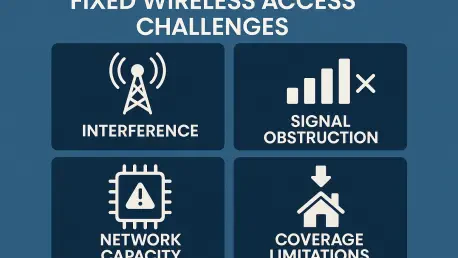Unveiling the FWA Challenge: A Critical Market Concern
In an era where broadband connectivity is paramount, Fixed Wireless Access (FWA) stands as a disruptive force for U.S. wireless carriers like Verizon, T-Mobile, and AT&T, offering a viable alternative to traditional cable internet. Yet, beneath this opportunity lies a startling statistic: FWA can account for up to 66% of network traffic while contributing a mere 6% to revenue. This glaring mismatch between data consumption and financial returns poses a significant challenge, threatening network sustainability and profitability. This market analysis delves into the heart of this disparity, exploring its implications for carriers and the broader wireless industry.
The purpose of this examination is to provide a comprehensive understanding of current trends, data-driven insights, and future projections surrounding FWA. As carriers position this technology as a cornerstone of broadband expansion, the stakes are high—balancing growth ambitions with operational constraints is no longer optional but essential. This analysis aims to unpack the complexities of resource allocation and strategic planning in a rapidly evolving market.
What makes this issue particularly pressing is its potential to reshape competitive dynamics. With millions of subscribers already on board and ambitious targets set for the coming years, the wireless sector stands at a crossroads. The following sections will analyze market patterns, highlight critical data points, and forecast potential trajectories, offering a roadmap for stakeholders navigating these turbulent waters.
Market Dynamics: Trends, Data, and Projections
FWA’s Explosive Growth and Competitive Edge
FWA has rapidly transformed from a niche offering into a significant player in the broadband arena, driven by advancements in 5G technology and the availability of midband spectrum. Carriers have leveraged this technology to challenge cable providers, particularly in rural and underserved regions where laying fiber is cost-prohibitive. The appeal lies in its relatively low deployment costs, allowing companies to tap into new markets without the burden of extensive infrastructure investments.
Recent data underscores the scale of adoption, with millions of households now relying on FWA for high-speed internet. This growth is not merely a trend but a strategic pivot, as carriers see FWA as a key avenue to capture market share from traditional broadband giants. However, this expansion comes with a hidden cost—while subscriber numbers climb, the financial returns remain disproportionately low compared to the resources consumed, setting the stage for deeper operational challenges.
The competitive landscape further intensifies the focus on FWA. As carriers roll out enhanced offerings, such as AT&T’s Internet Air product bolstered by newly acquired spectrum, the pressure to maintain service quality while managing costs mounts. This dynamic positions FWA as both a growth engine and a potential liability, depending on how effectively carriers adapt to emerging demands.
The Data-Revenue Imbalance: A Stark Market Reality
At the core of the FWA challenge is a profound imbalance between network traffic and revenue generation. Industry estimates reveal a staggering disparity: for some carriers, FWA constitutes roughly 50% to 66% of total wireless traffic, yet it accounts for just 3% to 6% of service revenue. This mismatch is driven by extraordinarily high data usage, with average monthly consumption per FWA subscriber reaching upwards of 580 to 635 gigabytes, compared to a modest 17.2 gigabytes for typical smartphone users.
This discrepancy creates a dual threat to carriers—network congestion and eroded profitability. The infrastructure required to support such heavy data loads demands substantial capital investment, yet the subscription fees collected from FWA users fail to offset these expenses. Without strategic interventions, this imbalance risks undermining the financial health of carriers, particularly those heavily invested in broadband expansion.
Geographic variations add another layer of complexity. In rural markets, where FWA often serves as the sole broadband option, consistently high usage strains sparse infrastructure. Urban areas, on the other hand, face intense competition from cable providers, pushing carriers to enhance capacity while keeping prices competitive. Addressing this market-wide issue will require innovative approaches to pricing and resource management tailored to regional needs.
Future Projections: Escalating Demands and AI Influence
Looking ahead, the pressure on carriers is set to intensify as data consumption continues to surge. Projections suggest that with ambitious subscriber targets—such as reaching 12 million for some carriers and 7 to 8 million for others by 2028—network traffic could nearly double or increase by over 80% within the next few years, assuming a conservative annual growth rate of 10% per user. This trajectory signals a looming capacity crisis if current trends persist unchecked.
The rise of artificial intelligence (AI)-driven applications adds fuel to this fire, with real-time processing and content generation expected to further spike bandwidth requirements. As AI becomes integral to consumer and business services, carriers must anticipate exponential increases in data needs, compounding the challenges already posed by FWA’s high usage patterns. The market must brace for a future where network strain becomes a defining issue.
Mitigating these risks will demand forward-thinking strategies. Potential solutions include tiered pricing models to align revenue with consumption or implementing data caps to curb excessive usage. However, such measures risk customer pushback in a market accustomed to unlimited plans. Balancing growth opportunities with infrastructure scalability remains a critical puzzle for industry leaders over the next few years.
Strategic Dilemmas and Spectrum Battles
Beyond raw data, carriers face philosophical and strategic questions about FWA’s role in their business models. Historically viewed as a way to monetize unused network capacity, FWA’s dominance in traffic consumption raises debates about whether it should bear a proportional share of network costs. This shift challenges long-standing assumptions that mobile services are the primary revenue driver, prompting a reevaluation of capital allocation priorities.
Spectrum acquisition emerges as a pivotal battleground in this context. Recent deals, such as those bolstering midband capacity, highlight the urgency of securing additional bandwidth to support FWA growth. Upcoming FCC auctions for critical licenses are expected to see fierce competition, as carriers vie for resources essential to alleviating traffic bottlenecks and sustaining service quality across diverse markets.
These strategic considerations extend to broader market positioning. As FWA evolves from a supplementary service to a potential core offering, carriers must decide whether to treat it as a distinct business line with dedicated investments. This decision could redefine competitive hierarchies, positioning wireless providers as primary broadband players in many regions while also reshaping investment landscapes for years to come.
Reflecting on the Market Analysis: Strategic Pathways Forward
This market analysis illuminated the profound challenges and opportunities surrounding Fixed Wireless Access for U.S. wireless carriers. The striking disparity between FWA’s data consumption and revenue contribution emerged as a central concern, with traffic proportions far outpacing financial returns. Projections of escalating demand, fueled by AI and subscriber growth, underscored the urgency of addressing network sustainability, while strategic debates about cost allocation and spectrum needs highlighted the complexity of navigating this evolving landscape.
Looking back, the insights gained pointed toward actionable steps that carriers could pursue to mitigate these issues. Exploring innovative pricing structures, such as usage-based billing or premium tiers for heavy users, offered a potential path to balance revenue with consumption. Aggressive investments in spectrum and infrastructure, alongside leveraging AI-driven traffic management tools, could provide the capacity needed to support growth. Additionally, monitoring regulatory shifts and advocating for favorable spectrum policies might position carriers to adapt more effectively to market demands.
Ultimately, the journey through this analysis suggested that success in the FWA space hinges on bold adaptation and a willingness to rethink traditional business models. For stakeholders, the next steps involve prioritizing scalability, fostering transparency in pricing policies, and preparing for a future where broadband connectivity redefines competitive boundaries. By taking proactive measures, the industry can transform FWA from a market challenge into a sustainable driver of growth and innovation.









